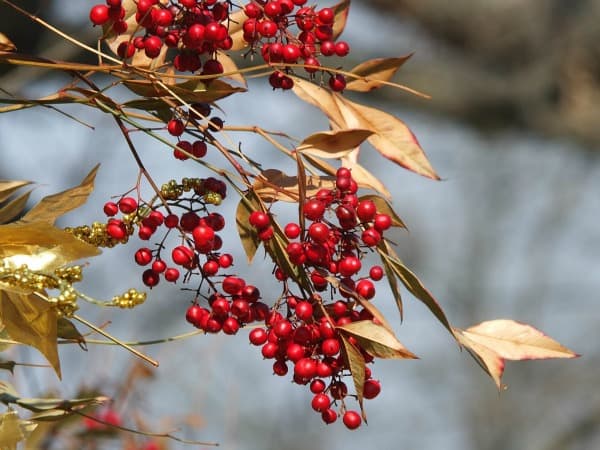Avoid planting Nandina (Nandina domesticata) in the garden if you love attracting birds to your garden. Some birds such as Cedar Waxwings have been poisoned by the berries. Here’s what you need to know about Nandina.
Why You Should Avoid Planting Nandina in the Garden
Nandina, also called Heavenly Bamboo, is a beautiful shrub. It grows like a weed here in southern Virginia, produces bright red berries which liven the winter landscape, and has pretty fall foliage. So what’s the problem?
Those bright red berries contain cyanide. You read that correctly. The berries contain cyanide and a few other chemicals that can be toxic to birds and animals.
Although Nandina has been grown in the United States for many years now, it was only in 2009 that researchers realized that a group of Cedar Waxwings had been poisoned by the berries. Scientists found five dead Cedar Waxwings in George and conducted a necropsy on them. They found that the birds had eaten a great quantity of Nandina berries. At first, they thought that the berries had blocked their crops, and that the birds hadn’t been able to digest them. Later, they realized they’d been poisoned by them.
Why did the birds eat the berries if they were poison? In their native habitat, both the local bird species and Nandina plants evolved together. Birds in Asia are either adapted to eating them or avoid them. North American song birds, however, don’t know what they are. So they eat them during lean times, especially in late winter, when most other food sources are exhausted.
Protecting Songbirds
The Cooperative Extension website recommends that homeowners with mature Nandina plants who wish to protect local song birds should snip off branches containing berries or remove the berries themselves.
Removing the entire plant from your garden and replacing it with a native shrub, such as Virginia sweetspire (Itea virginicana) or another native plant is a second option. It can be expensive, and many people don’t want to get rid of their Nandina plants, but I thought I’d mention it.
Additionally, some cultivars don’t produce berries, so they won’t harm the birds. Clemson’s Extension site has a list of cultivars that do not produce berries.
Should You Avoid Planting Nandina in the Garden?
I think that with the current knowledge available, the answer to whether you should avoid planting Nandina in the garden is “yes.” Don’t get me wrong; I love the plant. I have one planted as a foundation shrub. I just realized last spring how invasive it is when about a thousand seedlings sprang up in the mulch around the shrubs. I spent too many hours hand picking the seedlings out from among the azaleas.
I had no idea, however, that the plant may hurt birds or that the berries were poisonous. I knew that many berries were poisonous to people and pets, but my cats are so lazy and well fed they don’t bother with berries. I have never seen birds eating from this particular shrub, but I’m considering what to do with it now that I have this information.
The issue around Nandina just reminds me once more of the importance of choosing native plants for the landscape. So many of these non-native species turn invasive once they enter backyard gardens. Without natural predators or diseases, the plants just run wild. Kudzu, purple loosestrife, you name it there are plants that are now a problem because they were imported before we understood their impact on the environment. By choosing plants native to North America and especially to my home state of Virginia, I can be sure that I’m not adding anything harmful to the environment, and that the plants themselves will add to the local ecosystem by providing food or shelter to hungry animals, birds or insects.







This is interesting bits of information! I remember seeing trees like this a lot when I was a little kid, but I’m not quite sure where. However, it’s nice that people are teaching others about the dangers of this tree for songbirds.
Thank you so much for these great tips! I am learning so much from you already! Can’t wait for the Spring to work on some container gardens as I live in a townhouse. Have a great day!